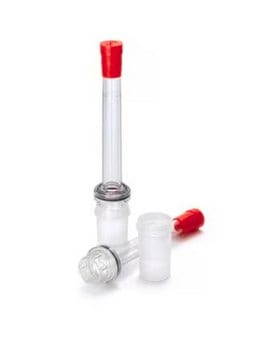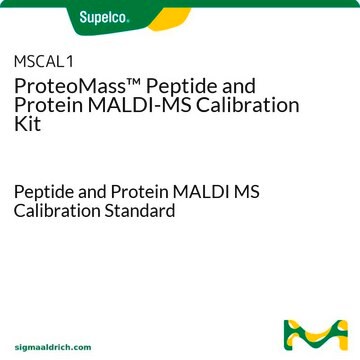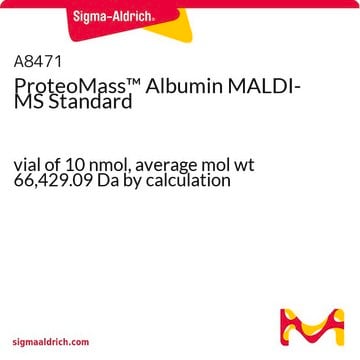49508
Sinapinsäure
matrix substance for MALDI-MS, ≥99.5%, Ultra pure
Synonym(e):
3,5-Dimethoxy-4-hydroxyzimtsäure, 4-Hydroxy-3,5-dimethoxy-zimtsäure
About This Item
Empfohlene Produkte
Qualität
matrix substance for MALDI-MS
Qualitätsniveau
Assay
≥99.5% (HPLC)
≥99.5%
chemische Klasse(n) des Analyten
dendrimers, fullerenes, peptides, proteins
Methode(n)
MALDI-MS: suitable
mp (Schmelzpunkt)
~202 °C
Löslichkeit
dioxane: 1 g/10 mL at hot, clear, faintly yellow to yellow
Kationenspuren
Al: ≤1 mg/kg
Ba: ≤1 mg/kg
Ca: ≤2 mg/kg
Cd: ≤1 mg/kg
Co: ≤1 mg/kg
Cr: ≤1 mg/kg
Cu: ≤1 mg/kg
Fe: ≤1 mg/kg
K: ≤2 mg/kg
Li: ≤1 mg/kg
Mg: ≤1 mg/kg
Mn: ≤1 mg/kg
Na: ≤2 mg/kg
Ni: ≤1 mg/kg
Sr: ≤1 mg/kg
Zn: ≤1 mg/kg
Eignung
in accordance for UV test
SMILES String
COc1cc(\C=C\C(O)=O)cc(OC)c1O
InChI
1S/C11H12O5/c1-15-8-5-7(3-4-10(12)13)6-9(16-2)11(8)14/h3-6,14H,1-2H3,(H,12,13)/b4-3+
InChIKey
PCMORTLOPMLEFB-ONEGZZNKSA-N
Suchen Sie nach ähnlichen Produkten? Aufrufen Leitfaden zum Produktvergleich
Verwandte Kategorien
Allgemeine Beschreibung
Anwendung
- Metabolic Fate Characterization: Sinapic acid′s metabolic fate in biological systems is a significant area of research. Recent studies in rats have focused on identifying the metabolic pathways and by-products of sinapic acid, using advanced techniques such as liquid chromatography-mass spectrometry (LC-MS). These studies provide insights into its bioavailability and pharmacokinetics, which are crucial for understanding its therapeutic potential (Analytical and Bioanalytical Chemistry, 2023).
- Efficient Extraction from Plant Materials: Sinapic acid is extracted from various plant sources using molecularly imprinted polymers (MIPs) and deep eutectic solvents. These methods enhance the efficiency and selectivity of sinapic acid extraction, making it a valuable approach for analytical chemists working on natural product isolation and characterization. This application is particularly relevant in the food and pharmaceutical industries for quality control and standardization (Food Chemistry, 2023).
- Selective Sensing Applications: Sinapic acid is used in the development of nanocomposites for selective sensing applications. For instance, Ni-sinapic acid nanocomposites have been developed for the selective detection of permanganate ions. This research showcases the versatility of sinapic acid in creating sensitive and specific sensors for environmental monitoring and analytical applications (Journal of Photochemistry and Photobiology A: Chemistry, 2023).
- Bioactivity Studies: The bioactivity of sinapic acid extends to its anti-inflammatory and anticancer properties. Studies have shown that sinapic acid can modulate various biochemical pathways, providing protective effects against inflammation and cancer. These findings underscore its potential as a bioactive compound in therapeutic formulations and highlight the importance of analytical methods in quantifying its efficacy and safety (Stem Cell Research International, 2022).
Biochem./physiol. Wirkung
Verpackung
Ähnliches Produkt
Signalwort
Warning
H-Sätze
Gefahreneinstufungen
Eye Irrit. 2 - Skin Irrit. 2 - STOT SE 3
Zielorgane
Respiratory system
Lagerklassenschlüssel
11 - Combustible Solids
WGK
WGK 3
Flammpunkt (°F)
Not applicable
Flammpunkt (°C)
Not applicable
Persönliche Schutzausrüstung
dust mask type N95 (US), Eyeshields, Gloves
Choose from one of the most recent versions:
Analysenzertifikate (COA)
Don't see the Right Version?
If you require a particular version, you can look up a specific certificate by the Lot or Batch number.
Besitzen Sie dieses Produkt bereits?
In der Dokumentenbibliothek finden Sie die Dokumentation zu den Produkten, die Sie kürzlich erworben haben.
Kunden haben sich ebenfalls angesehen
Artikel
One of the most important aspects of our ultra-pure MALDI matrix substances is their ability to dissolve rapidly and completely; a brief vortex mixing is typically sufficient.
Unser Team von Wissenschaftlern verfügt über Erfahrung in allen Forschungsbereichen einschließlich Life Science, Materialwissenschaften, chemischer Synthese, Chromatographie, Analytik und vielen mehr..
Setzen Sie sich mit dem technischen Dienst in Verbindung.





![trans-2-[3-(4-tert-Butylphenyl)-2-methyl-2-propenyliden]malononitril matrix substance for MALDI-MS, ≥99.0% (HPLC)](/deepweb/assets/sigmaaldrich/product/structures/249/587/f8021369-f65a-413d-887d-3c8a4d2a248f/640/f8021369-f65a-413d-887d-3c8a4d2a248f.png)




